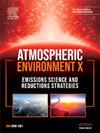双燃料液化天然气动力游轮的船上排放测量:海上试验研究
IF 3.4
Q2 ENVIRONMENTAL SCIENCES
引用次数: 0
摘要
液化天然气(LNG)在双燃料发动机中的使用正在海事行业扩大,使其符合硫和氮氧化物排放法规,同时也减少了大气中颗粒污染物的排放。与海洋瓦斯油(MGO)等液体燃料相比,液化天然气进一步减少了二氧化碳的直接排放,这也有助于满足海上运输中的温室气体排放(GHG)减少要求。然而,双燃料发动机排放的未燃烧甲烷仍是一个有待改进的领域。在这项研究中,我们在一艘新游轮的海试中监测了一台四冲程双燃料发动机未燃烧的甲烷以及其他气体和颗粒污染物的大气排放,使用了这些发动机可以运行的LNG和MGO燃料。在该船的调试阶段,我们能够在大范围的发动机负载下进行测量,并确认低负载下未燃烧甲烷的排放系数较高:在发动机负载60%至95%之间,排放系数保持相对稳定在2.3 g.kWh - 1左右,但在低负载下增加,达到8.5 g.kWh - 1负载25%。对于细颗粒物排放,其特征是大于23纳米(PN23)的颗粒数量,我们确定从MGO切换到LNG导致发动机在高负荷下排放的PN23颗粒减少因子约为136。MGO模式下的实测排放水平相对独立于发动机负荷,而LNG模式下的实测排放水平则随着发动机负荷的降低而增加。根据我们对甲烷和二氧化碳的测量,我们提出了温室气体排放水平作为发动机负荷函数的比较,结果表明,在75%的负荷下,从LNG切换到MGO会导致二氧化碳当量排放量相对增加18%。最后,我们在3个月的商业运营期间获得了发动机负载监测(ELM)。得到的负荷分布表明,柴电结构根据船舶的能量需求调整发动机的运行数量和负荷,这限制了发动机在低负荷下的使用。因此,不到7%的发动机工作时间是在低于30%的负荷下度过的,超过这个阈值,所研究的发动机的排放量将低于默认的FuelEU值3.1%。在考虑使用加权平均值时,基于船上测量的排放系数和发动机负载监测(ELM)得出的负载分布,我们得到的排放系数为3.2 g.kWh−1,即燃料使用量的1.7%。这个1.7%的值低于FuelEU法规规定的值,它似乎代表了该船的实际排放量及其在运行条件下的使用情况。本文章由计算机程序翻译,如有差异,请以英文原文为准。
On-Board measurement of emissions on a dual fuel LNG powered cruise ship: A sea trial study
The use of liquefied natural gas (LNG) in dual-fuel engines is expanding in the maritime industry, enabling compliance with sulfur and nitrogen oxide emissions regulations, while also reducing atmospheric emissions of particulate pollutants. LNG further allows for a reduction in direct CO2 emissions compared to liquid fuels such as marine gas oil (MGO), which also helps meet greenhouse gas emission (GHG) reduction requirements in maritime transport. However, unburned methane emitted by dual-fueled engines remains an area for improvement. In this study, we monitored the atmospheric emissions of unburned methane, along with other gaseous and particulate pollutants, from a 4-stroke dual-fuel engine during sea trials of a new cruise ship, using both LNG and MGO fuels that these engines can operate on. During this ship's commissioning phase, we were able to perform measurements across a wide range of engine loads and confirm higher emission factors for unburned methane at low loads: the emission factor remains relatively stable at around 2.3 g.kWh−1 between 60% and 95% engine load, but increases at lower loads, reaching 8.5 g.kWh−1 at 25% load. For fine particulate emissions, characterized by the number of particles larger than 23 nm (PN23), we established that switching from MGO to LNG results in a reduction factor of approximately 136 in PN23 particles emitted by the engine at high load. The measured emission levels in MGO mode were relatively independent of engine load but tended to increase in LNG mode as engine load decreased. Based on our measurements of methane and CO2, we propose a comparison of GHG emission levels as a function of engine load, which shows that switching from LNG to MGO at 75% load results in an 18% relative increase in CO2 equivalent emissions. Finally, we had access to engine load monitoring (ELM) during commercial operation over a 3-month period. The load distribution obtained shows that the diesel-electric architecture, which adjusts the number of engines in operation and their load according to the vessel's energy demands, leads to a limitation in the use of the engine at low load. As a result, less than 7% of the engine operating time is spent at a load below 30%, a threshold beyond which the studied engine emits less than the default FuelEU value of 3.1%. When considering a usage-weighted average, based on the emission factors measured on board and the load distribution derived from the Engine Load Monitoring (ELM), we obtain an emission factor of 3.2 g.kWh−1, or 1.7% of the fuel use. This value of 1.7% is lower than that specified by the FuelEU regulation, and it appears to be representative of the actual emissions of this vessel and its usage under operational conditions.
求助全文
通过发布文献求助,成功后即可免费获取论文全文。
去求助
来源期刊

Atmospheric Environment: X
Environmental Science-Environmental Science (all)
CiteScore
8.00
自引率
0.00%
发文量
47
审稿时长
12 weeks
 求助内容:
求助内容: 应助结果提醒方式:
应助结果提醒方式:


